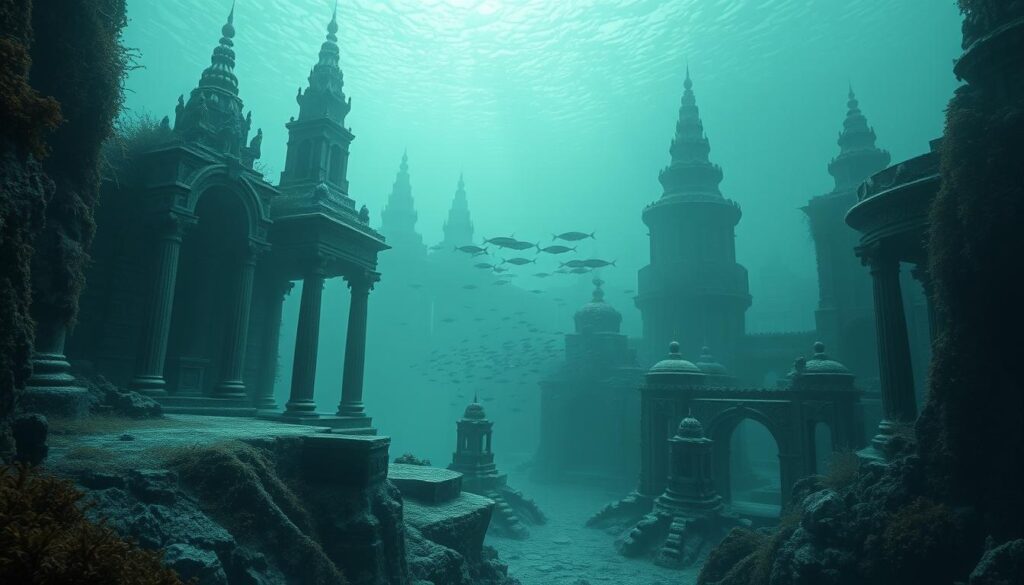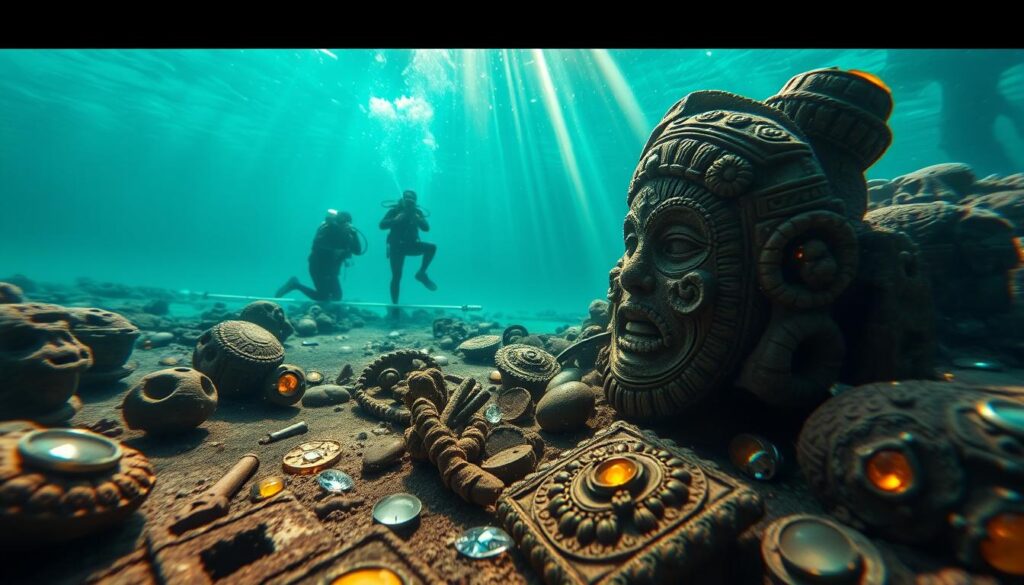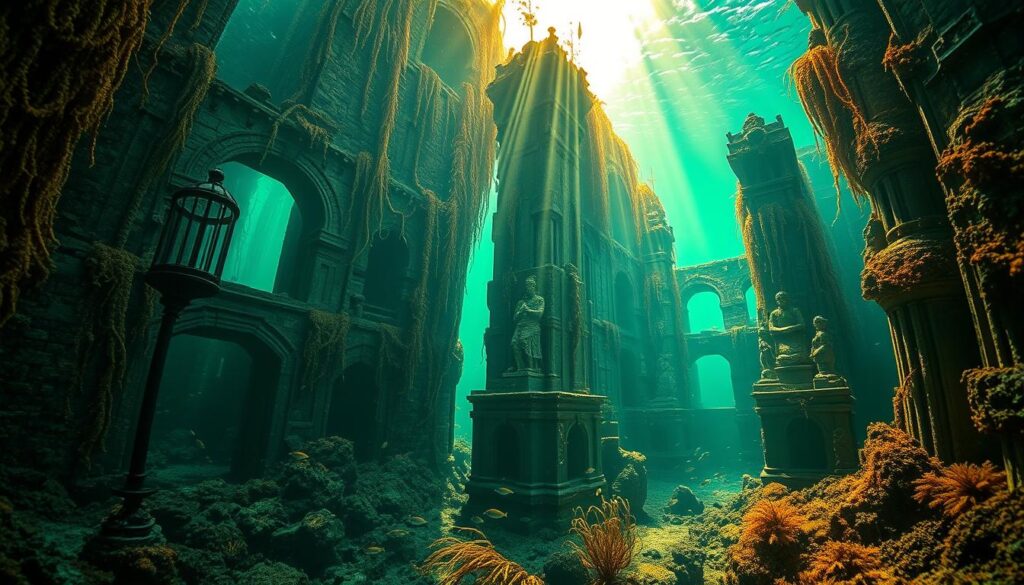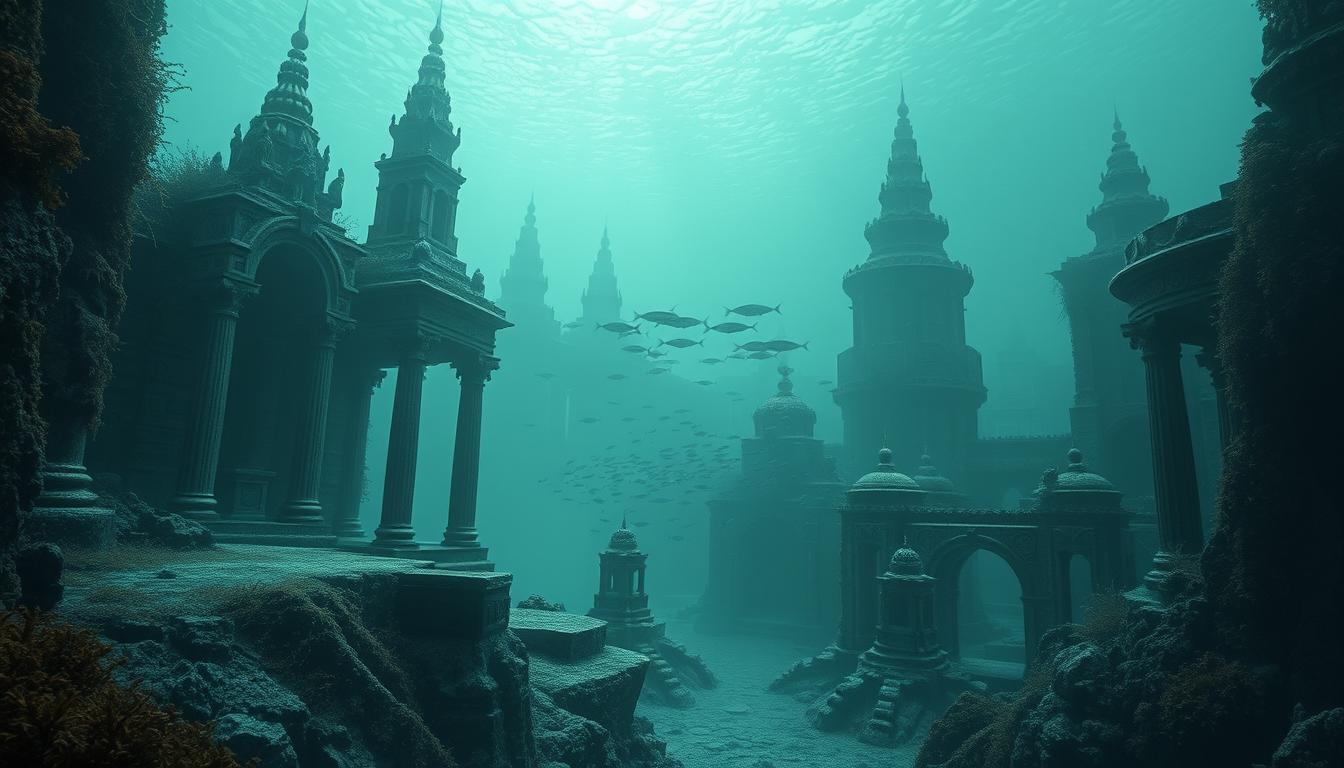Forgotten Underwater City – The ocean is full of secrets and stories from the past. Underwater archaeology helps us find these stories. Finding a forgotten underwater city is exciting, mixing history, mystery, and the unknown.
Exploring this city, we find a place that was once alive. It’s hidden for centuries. It shows how smart humans were and how strong the sea is. Studying it helps us learn about our ancestors and their world.

Introduction to the Forgotten Underwater City
The forgotten underwater city is full of mysteries. As we learn about it, we uncover its secrets. This includes where it came from, how people lived there, and why it sank.
By studying this city, we understand underwater archaeology better. It’s important for learning about our past.
Key Takeaways Forgotten Underwater City
- The forgotten underwater city is a significant find in the field of underwater archaeology
- Underwater archaeology is a vital field of study, uncovering the remnants of forgotten civilizations
- The forgotten underwater city is a testament to human ingenuity and the power of the sea
- The study of the forgotten underwater city provides valuable insights into the lives of our ancestors
- Exploring the forgotten underwater city can help us gain a deeper understanding of the field of underwater archaeology
- The forgotten underwater city is an enigmatic place, full of mysteries waiting to be solved
The Remarkable Discovery Beneath the Waves
Marine archaeology has uncovered many submerged ruins, but none as exciting as the forgotten underwater city. These ruins, hidden for centuries, started an amazing journey. Researchers found signs of ancient life, including structures that stood against seawater’s damage.
Finding the first archaeological evidence was hard work. But it showed life in a long-lost time. The team worked hard to date the city, using artifacts and buildings to tell its story. This showed the skill and creativity of the city’s people, changing marine archaeology forever.
Uncovering the Secrets of the Past
The discovery of the forgotten underwater city shows marine archaeology’s power. By studying these ruins, researchers learn about ancient lives. Advanced technology, like underwater mapping, helps us explore these sites in great detail.
Challenges and Opportunities
Marine archaeologists face many challenges, but the underwater city’s discovery brings new chances. As we learn more, we see why preserving our heritage is key. Studying these ruins is crucial, and it could uncover many more secrets of the past.
Origins of the Forgotten Underwater City
The story of ancient cities like the forgotten underwater city is captivating. These cities were often built for strategic reasons. They were near trade routes, fertile land, or had strong defenses.
The city’s founders were incredibly skilled. They built a thriving city that lasted for many generations. Their knowledge and skills were unmatched.
Preserving ancient cities is vital. It lets us see how societies have changed over time. It also shows how the environment has shaped cities.
By studying the forgotten underwater city, we learn a lot. We understand why it was built and its importance in history. Some reasons for its founding include:
- Access to natural resources, such as fish and other seafood
- Strategic location for trade and commerce
- Defensible position, protecting the city from potential threats
Studying ancient cities like the forgotten underwater city is key. It helps us understand the past better. It also teaches us about the people who built these cities.
This knowledge helps us plan cities better today. It guides us to make cities more sustainable and resilient for the future.
Life in the Ancient Metropolis
The forgotten underwater city was full of life and complexity. Oceanic discoveries show a society with a strong social structure and economy. The city’s design made the most of space and resources, with buildings that helped community and trade.
Exploration has shown us how the city worked. People farmed, crafted, and traded. The buildings, now underwater, were engineering marvels, built to last.
- Daily routines: farming, craftsmanship, and trade
- Social structure: a well-organized society with a thriving economy
- Architecture: sophisticated buildings and public spaces that facilitated community life and economic activity
Daily Routines and Social Structure
The city’s people were deeply connected to the ocean. Their days were filled with farming, crafting, and trading. A smart urban plan helped use resources well.
Architecture and Urban Planning
The buildings were made to last, using advanced techniques. The city’s layout helped community and trade, with spaces for people to gather.
Trade and Commerce Systems
The city’s trade was booming, with merchants and traders everywhere. A system of exploration and discovery helped expand trade and find new resources.
The Great Submergence: How Nature Claimed the City
The story of the forgotten underwater city is captivating. Archaeological findings show that natural disasters were key in its downfall. Underwater archaeology has helped reveal how nature’s power led to its submergence.
Several factors might have led to the city’s sinking:
- Earthquakes could have caused massive damage and altered the city’s layout.
- Floods might have happened because of sea level changes or extreme weather.
- Slowly rising sea levels could have also pushed the city underwater.
These disasters, happening over many years, slowly took the city under the sea. This process preserved many of its buildings and treasures. The field of underwater archaeology is key to understanding the city’s past and how nature affects human settlements.
It’s vital to protect our cultural heritage as the environment changes. By studying the forgotten underwater city, we learn about the importance of archaeological findings. We also see the crucial role of underwater archaeology in uncovering history’s secrets.
Architectural Marvels That Survived Time
The forgotten underwater city is a treasure trove of architectural wonders. Structures here have stood the test of time. Despite being submerged for centuries, the city’s buildings show the engineering and artistic skills of their creators.
The field of marine archaeology has been key in exploring and preserving these submerged ruins. It lets us learn from and appreciate these ancient marvels.
Some of the most notable architectural achievements include:
- Temple complexes and religious sites, which showcase the city’s spiritual heart
- Residential districts, with their well-planned homes and community spaces, offering a glimpse into the daily lives of the city’s inhabitants
- Public spaces and markets, which evoke the vibrancy of a once-thriving commercial center
These structures are a testament to the city’s rich history and cultural significance. Their preservation is essential for future generations to learn from and appreciate. The use of marine archaeology techniques has enabled researchers to study and protect these submerged ruins, ensuring their survival for years to come.
The study of these architectural marvels has also provided valuable insights into the city’s past. It includes its social structure, trade networks, and cultural practices. By examining the city’s submerged ruins, researchers can gain a deeper understanding of the city’s history and its significance in the context of marine archaeology.
Artifacts and Treasures from the Deep
The underwater city has given us many artifacts. Each one tells a story of the city’s past. We’ve found pottery, tools, jewelry, and ceremonial objects. These items help us understand the city’s culture and daily life.
Some of the most interesting finds include:
- Ceremonial masks made of gold and precious stones
- Intricately carved pottery with ancient symbols and markings
- Tools made of bronze and copper, showing the city’s metalworking skills
These oceanic discoveries show why we must explore and protect our underwater heritage. They help us learn about ancient civilizations. By studying these artifacts, we can understand the city’s history better.

These finds are very important for understanding the city’s past. They remind us of the need to keep our cultural heritage safe. As we learn more about the underwater city, we see how crucial it is to preserve our history.
Modern Technology Unveiling Ancient Secrets
Underwater exploration has become more efficient with modern technology. This allows researchers to find archaeological findings that were once hidden. Advanced technologies help us understand submerged ruins better, leading to more accurate interpretations.
Some of the key technologies used in underwater archaeology include:
- Underwater mapping techniques, which enable detailed surveying of submerged sites
- 3D reconstruction methods, which can bring ancient structures back to life in stunning detail
- Conservation technologies, which play a critical role in preserving artifacts and sites for future generations
These technologies have opened new ways to explore underwater sites. They let researchers study submerged sites in more detail. This has led to significant discoveries, revealing more about ancient civilizations.
As researchers keep improving these technologies, we’ll learn even more about the past. We’ll gain a deeper understanding of human history and the cultures that shaped our world. The mix of modern tech and underwater exploration is a powerful tool for discovery, with endless possibilities.
Preservation Efforts and Future Excavations
Keeping the forgotten underwater city safe is a big job. It needs teamwork from archaeologists, conservators, and leaders. The city’s underwater setting is both a challenge and an opportunity for saving it. Underwater archaeology is key to learning about this ancient place, with more discoveries expected.
Some important steps to save the city include:
- Keeping the site safe from people and pollution
- Using new tech to protect the city’s buildings and treasures
- Supporting studies and teaching to show why we must save our history
Future digs will use cool tech like remote-operated vehicles and 3D scanning. These tools will help us see more of the city’s past. They will also help us learn how to keep it safe for the future. This underwater city is a treasure that shows our history and the struggles of our ancestors.

By backing these efforts, we can keep this amazing piece of history alive. The forgotten underwater city shows how vital underwater archaeology is. Saving it proves our dedication to keeping our cultural heritage alive.
The Impact of This Forgotten Underwater City on Modern Archaeology
The discovery of the forgotten underwater city has changed archaeology a lot. It has especially impacted ancient cities and marine archaeology. This find has made us rethink old ideas and ways of doing things. It has opened up new paths for studying and exploring.
By looking at ancient cities, both on land and underwater, we learn more. We understand how cities grew, cultures mixed, and people coped with tough environments.
Some key parts of marine archaeology have helped us understand better. These include:
- Advanced technologies for exploring and preserving submerged sites
- New ways to analyze and understand archaeological data
- Working together from different fields to see how humans and nature interact
Studying ancient cities also shows us how important cultural exchange is. By looking at these cities, we can see how people lived, traded, and innovated. This knowledge helps us understand our own history and how societies have evolved.
Conclusion: Preserving Our Submerged Heritage
As we say goodbye to the underwater city’s story, it’s clear that saving our underwater history is crucial. These sites under the sea are more than old relics. They show the strength and creativity of past societies.
Underwater archaeology has given us a new view of human history. It reveals the victories and struggles of our ancestors. Finding this lost city reminds us that our heritage is not just on land, but also in the ocean.
Now, it’s up to us to keep these sites safe for those who come after us. By protecting these treasures, we honor the past and teach others about our rich heritage.
FAQ
What is the significance of the discovery of the forgotten underwater city?
Finding the forgotten underwater city is big news. It lets us see what life was like in an ancient civilization. The city’s ruins under the sea tell us about its history, buildings, and how people lived and traded.
How did marine archaeologists uncover the first signs of this ancient city?
Marine archaeologists used cool tech and careful research to find the city. They found ruins and other clues that showed where the city was. Then, they started to learn when and how it was built.
What factors may have contributed to the submergence of the city?
Scientists think earthquakes, floods, and sea level changes might have sunk the city. These events happened over time, slowly covering the city. This helped keep many of its buildings and things intact.
What architectural marvels have been discovered in the submerged city?
The city has amazing buildings that lasted for centuries. There are temples, homes, and markets. These show the city’s builders were very skilled, giving us a peek into their lives.
What types of artifacts have been found in the underwater city?
The city has lots of cool finds, like pottery and jewelry. These items help us understand the city’s culture and how people lived. They’re very important for learning about the past.
How have modern technologies enhanced the exploration and preservation of the submerged city?
New tech has changed underwater archaeology a lot. Tools like underwater mapping help us see the city better. This makes studying and saving the site easier, opening up new ways to explore.
What are the ongoing efforts to preserve the forgotten underwater city?
Saving the city is a team effort. Archaeologists, conservators, and others work together. They keep exploring and learning, uncovering more secrets. It’s important to protect these sites for future generations.
Source link
- https://en.wikipedia.org/wiki/The_Hands_Resist_Him
- https://www.telegraph.co.uk/art/artists/internets-haunted-paintingthe-bizarre-story-behind-hands-resist/
- https://www.pinotspalette.com/bricktown/blog/wine-entertaining/the-most-haunted-painting-in-america
- https://substack.com/home/post/p-150779211?utm_campaign=post&utm_medium=web
- https://observer.com/2024/10/haunted-paintings-munch-beksinski-landseer-cursed-artwork/
